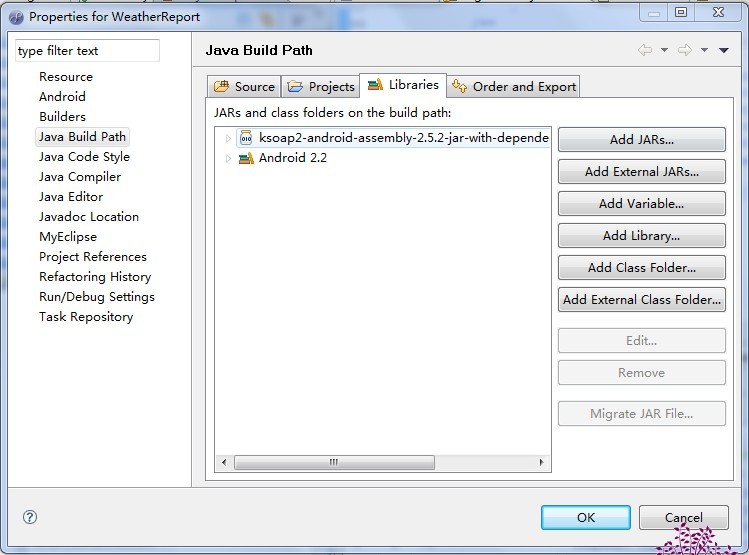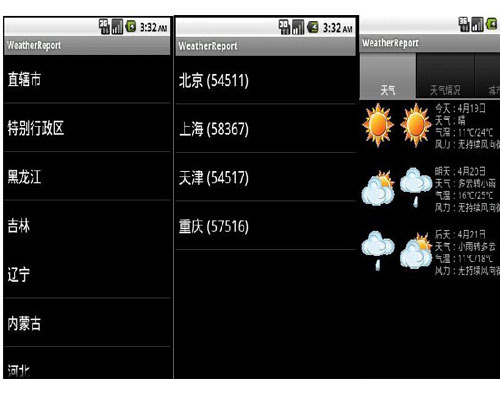今天就跟大家聊聊有关Android中怎么与服务器端数据进行交互,可能很多人都不太了解,为了让大家更加了解,小编给大家总结了以下内容,希望大家根据这篇文章可以有所收获。
首先下载KSOAP包:
ksoap2-android-assembly-2.5.2-jar-with-dependencies.jar然后新建android项目:并把下载的KSOAP包放在android项目的lib目录下:右键->build path->configure build path--选择Libraries,如图:

以下分为七个步骤来调用WebService方法:
1、实例化SoapObject 对象,指定webService的命名空间(从相关WSDL文档中可以查看命名空间),以及调用方法名称。如:
//命名空间 private static final String serviceNameSpace="http://WebXml.com.cn/"; //调用方法(获得支持的城市) private static final String getSupportCity="getSupportCity"; //实例化SoapObject对象 SoapObject request=new SoapObject(serviceNameSpace, getSupportCity);2、假设方法有参数的话,设置调用方法参数
request.addProperty("参数名称","参数值");3、设置SOAP请求信息(参数部分为SOAP协议版本号,与你要调用的webService中版本号一致):
//获得序列化的Envelope SoapSerializationEnvelope envelope=new SoapSerializationEnvelope(SoapEnvelope.VER11); envelope.bodyOut=request;4、注册Envelope,
(new MarshalBase64()).register(envelope);5、构建传输对象,并指明WSDL文档URL:
//请求URL private static final String serviceURL="http://www.webxml.com.cn/webservices/weatherwebservice.asmx"; //Android传输对象 AndroidHttpTransport transport=new AndroidHttpTransport(serviceURL); transport.debug=true;6、调用WebService(其中参数为1:命名空间+方法名称,2:Envelope对象):
transport.call(serviceNameSpace+getWeatherbyCityName, envelope);7、解析返回数据:
if(envelope.getResponse()!=null){ return parse(envelope.bodyIn.toString()); } /************** * 解析XML * @param str * @return */ private static List<String> parse(String str){ String temp; List<String> list=new ArrayList<String>(); if(str!=null && str.length()>0){ int start=str.indexOf("string"); int end=str.lastIndexOf(";"); temp=str.substring(start, end-3); String []test=temp.split(";"); for(int i=0;i<test.length;i++){ if(i==0){ temp=test[i].substring(7); }else{ temp=test[i].substring(8); } int index=temp.indexOf(","); list.add(temp.substring(0, index)); } } return list; }这样就成功啦。那么现在我们就来测试下吧,这里有个地址提供webService天气预报的服务的,我这里只提供获取城市列表:
//命名空间 private static final String serviceNameSpace="http://WebXml.com.cn/"; //请求URL private static final String serviceURL="http://www.webxml.com.cn/webservices/weatherwebservice.asmx"; //调用方法(获得支持的城市) private static final String getSupportCity="getSupportCity"; //调用城市的方法(需要带参数) private static final String getWeatherbyCityName="getWeatherbyCityName"; //调用省或者直辖市的方法(获得支持的省份或直辖市) private static final String getSupportProvince="getSupportProvince";我们选择获取国内外主要城市或者省份的方法吧:getSupportProvice,然后调用,你会发现浏览器返回给我们的是xml文档:
<?xml version="1.0" encoding="utf-8" ?> <ArrayOfString xmlns:xsi="http://www.w3.org/2001/XMLSchema-instance" xmlns:xsd="http://www.w3.org/2001/XMLSchema" xmlns="http://WebXml.com.cn/"> <string>直辖市</string> <string>特别行政区</string> <string>黑龙江</string> <string>吉林</string> <string>辽宁</string> <string>内蒙古</string> <string>河北</string> <string>河南</string> <string>山东</string> <string>山西</string> <string>江苏</string> <string>安徽</string> <string>陕西</string> <string>宁夏</string> <string>甘肃</string> <string>青海</string> <string>湖北</string> <string>湖南</string> <string>浙江</string> <string>江西</string> <string>福建</string> <string>贵州</string> <string>四川</string> <string>广东</string> <string>广西</string> <string>云南</string> <string>海南</string> <string>新疆</string> <string>西藏</string> <string>台湾</string> <string>亚洲</string> <string>欧洲</string> <string>非洲</string> <string>北美洲</string> <string>南美洲</string> <string>大洋洲</string> </ArrayOfString>我们可以用 listview来显示:
那么下面我将给出全部代码:
public class WebServiceHelper { //WSDL文档中的命名空间 private static final String targetNameSpace="http://WebXml.com.cn/"; //WSDL文档中的URL private static final String WSDL="http://webservice.webxml.com.cn/WebServices/WeatherWebService.asmx?wsdl"; //需要调用的方法名(获得本天气预报Web Services支持的洲、国内外省份和城市信息) private static final String getSupportProvince="getSupportProvince"; //需要调用的方法名(获得本天气预报Web Services支持的城市信息,根据省份查询城市集合:带参数) private static final String getSupportCity="getSupportCity"; //根据城市或地区名称查询获得未来三天内天气情况、现在的天气实况、天气和生活指数 private static final String getWeatherbyCityName="getWeatherbyCityName"; /******** * 获得州,国内外省份和城市信息 * @return */ public List<String> getProvince(){ List<String> provinces=new ArrayList<String>(); String str=""; SoapObject soapObject=new SoapObject(targetNameSpace,getSupportProvince); //request.addProperty("参数", "参数值");调用的方法参数与参数值(根据具体需要可选可不选) SoapSerializationEnvelope envelope=new SoapSerializationEnvelope(SoapEnvelope.VER11); envelope.dotNet=true; envelope.setOutputSoapObject(soapObject);//envelope.bodyOut=request; AndroidHttpTransport httpTranstation=new AndroidHttpTransport(WSDL); //或者HttpTransportSE httpTranstation=new HttpTransportSE(WSDL); try { httpTranstation.call(targetNameSpace+getSupportProvince, envelope); SoapObject result=(SoapObject)envelope.getResponse(); //下面对结果进行解析,结构类似json对象 //str=(String) result.getProperty(6).toString(); int count=result.getPropertyCount(); for(int index=0;index<count;index++){ provinces.add(result.getProperty(index).toString()); } } catch (IOException e) { // TODO Auto-generated catch block e.printStackTrace(); } catch (XmlPullParserException e) { // TODO Auto-generated catch block e.printStackTrace(); } return provinces; } /********** * 根据省份或者直辖市获取天气预报所支持的城市集合 * @param province * @return */ public List<String> getCitys(String province){ List<String> citys=new ArrayList<String>(); SoapObject soapObject=new SoapObject(targetNameSpace,getSupportCity); soapObject.addProperty("byProvinceName", province); SoapSerializationEnvelope envelope=new SoapSerializationEnvelope(SoapEnvelope.VER11); envelope.dotNet=true; envelope.setOutputSoapObject(soapObject); AndroidHttpTransport httpTransport=new AndroidHttpTransport(WSDL); try { httpTransport.call(targetNameSpace+getSupportCity, envelope); SoapObject result=(SoapObject)envelope.getResponse(); int count=result.getPropertyCount(); for(int index=0;index<count;index++){ citys.add(result.getProperty(index).toString()); } } catch (IOException e) { // TODO Auto-generated catch block e.printStackTrace(); } catch (XmlPullParserException e) { // TODO Auto-generated catch block e.printStackTrace(); } return citys; } /*************************** * 根据城市信息获取天气预报信息 * @param city * @return ***************************/ public WeatherBean getWeatherByCity(String city){ WeatherBean bean=new WeatherBean(); SoapObject soapObject=new SoapObject(targetNameSpace,getWeatherbyCityName); soapObject.addProperty("theCityName",city);//调用的方法参数与参数值(根据具体需要可选可不选) SoapSerializationEnvelope envelope=new SoapSerializationEnvelope(SoapEnvelope.VER11); envelope.dotNet=true; envelope.setOutputSoapObject(soapObject);//envelope.bodyOut=request; AndroidHttpTransport httpTranstation=new AndroidHttpTransport(WSDL); //或者HttpTransportSE httpTranstation=new HttpTransportSE(WSDL); try { httpTranstation.call(targetNameSpace+getWeatherbyCityName, envelope); SoapObject result=(SoapObject)envelope.getResponse(); //下面对结果进行解析,结构类似json对象 bean=parserWeather(result); } catch (IOException e) { // TODO Auto-generated catch block e.printStackTrace(); } catch (XmlPullParserException e) { // TODO Auto-generated catch block e.printStackTrace(); } return bean; } /** * 解析返回的结果 * @param soapObject */ protected WeatherBean parserWeather(SoapObject soapObject){ WeatherBean bean=new WeatherBean(); List<Map<String,Object>> list=new ArrayList<Map<String,Object>>(); Map<String,Object> map=new HashMap<String,Object>();//城市名 bean.setCityName(soapObject.getProperty(1).toString());//城市简介 bean.setCityDescription(soapObject.getProperty(soapObject.getPropertyCount()-1).toString()); bean.setLiveWeather(soapObject.getProperty(10).toString()+"\n"+soapObject.getProperty(11).toString()); //其他数据 //日期, String date=soapObject.getProperty(6).toString(); String weatherToday="今天:" + date.split(" ")[0]; weatherToday+="\n天气:"+ date.split(" ")[1]; weatherToday+="\n气温:"+soapObject.getProperty(5).toString(); weatherToday+="\n风力:"+soapObject.getProperty(7).toString(); weatherToday+="\n"; List<Integer> icons=new ArrayList<Integer>(); icons.add(parseIcon(soapObject.getProperty(8).toString())); icons.add(parseIcon(soapObject.getProperty(9).toString())); map.put("weatherDay", weatherToday); map.put("icons",icons); list.add(map); map=new HashMap<String,Object>(); date=soapObject.getProperty(13).toString(); String weatherTomorrow="明天:" + date.split(" ")[0]; weatherTomorrow+="\n天气:"+ date.split(" ")[1]; weatherTomorrow+="\n气温:"+soapObject.getProperty(12).toString(); weatherTomorrow+="\n风力:"+soapObject.getProperty(14).toString(); weatherTomorrow+="\n"; icons=new ArrayList<Integer>(); icons.add(parseIcon(soapObject.getProperty(15).toString())); icons.add(parseIcon(soapObject.getProperty(16).toString())); map.put("weatherDay", weatherTomorrow); map.put("icons",icons); list.add(map); map=new HashMap<String,Object>(); date=soapObject.getProperty(18).toString(); String weatherAfterTomorrow="后天:" + date.split(" ")[0]; weatherAfterTomorrow+="\n天气:"+ date.split(" ")[1]; weatherAfterTomorrow+="\n气温:"+soapObject.getProperty(17).toString(); weatherAfterTomorrow+="\n风力:"+soapObject.getProperty(19).toString(); weatherAfterTomorrow+="\n"; icons=new ArrayList<Integer>(); icons.add(parseIcon(soapObject.getProperty(20).toString())); icons.add(parseIcon(soapObject.getProperty(21).toString())); map.put("weatherDay", weatherAfterTomorrow); map.put("icons",icons); list.add(map); bean.setList(list); return bean; } //解析图标字符串 private int parseIcon(String data){ // 0.gif,返回名称0, int resID=32; String result=data.substring(0, data.length()-4).trim(); // String []icon=data.split("."); // String result=icon[0].trim(); // Log.e("this is the icon", result.trim()); if(!result.equals("nothing")){ resID=Integer.parseInt(result.trim()); } return resID; //return ("a_"+data).split(".")[0]; } }上就是我所作的查询天气预报的全部核心代码了,读者可以根据注释以及本文章了解下具体实现,相信很快就搞明白了,运行结果如下:

看完上述内容,你们对Android中怎么与服务器端数据进行交互有进一步的了解吗?如果还想了解更多知识或者相关内容,请关注亿速云行业资讯频道,感谢大家的支持。
亿速云「云服务器」,即开即用、新一代英特尔至强铂金CPU、三副本存储NVMe SSD云盘,价格低至29元/月。点击查看>>
免责声明:本站发布的内容(图片、视频和文字)以原创、转载和分享为主,文章观点不代表本网站立场,如果涉及侵权请联系站长邮箱:is@yisu.com进行举报,并提供相关证据,一经查实,将立刻删除涉嫌侵权内容。